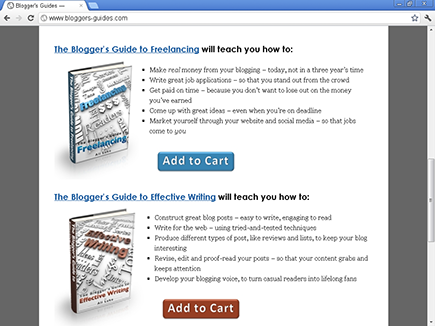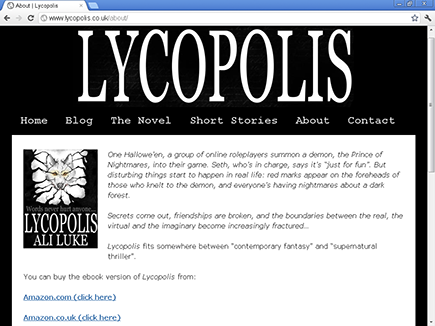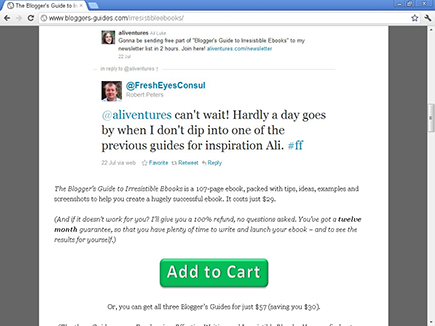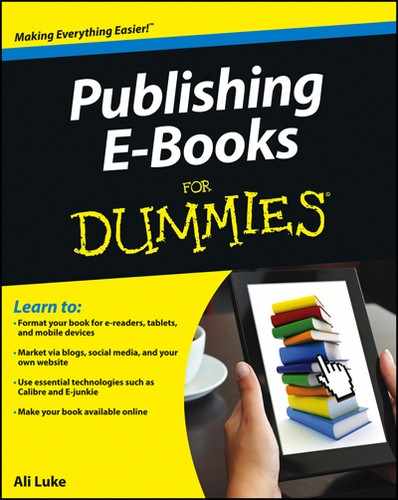Figure 10-2: The Add to Cart button.
Including Crucial Elements on Your E-Book’s Sales Page
Whatever type of e-book you’ve written — whether it’s a specialist, in-depth nonfiction guide or a genre novel — you need to put in place on your sales page all the essential elements described in this section.
A clear explanation of your e-book
Readers need to know what they’re buying. That means giving them more than simply your e-book’s title and its cover image. It might seem obvious to you what your e-book’s about, but don’t make assumptions about what the reader is and isn’t familiar with.
For example, if you’ve written a thriller novel, use the word thriller somewhere in your description. (You probably want to be more specific, too. Is it a psychological thriller? A supernatural thriller? A technothriller?) Offer readers a hook to entice them — in the way that the blurb on the back of a book does.
If your e-book is nonfiction, clearly explain its scope. Rather than say that it’s “advanced” or “for beginners” (which are rather subjective measurements), try to indicate the level that the reader should already have reached. If you’ve written a guide to basic plumbing, for example, you might simply say, “I walk you through it step-by-step, and I don’t expect you to have experience.” If you’ve written an advanced e-book on website design, you might say, “I assume that you have a working knowledge of HTML and CSS.”
Explain how the e-book will be provided. You might need to offer extra guidance if your readers may not be used to buying e-books, using wording such as the examples in this list:
![]() You can buy [e-book title] direct from Amazon, to read on your Kindle or on a free Kindle app (available for PCs, Macs, tablet computers, and smartphones).
You can buy [e-book title] direct from Amazon, to read on your Kindle or on a free Kindle app (available for PCs, Macs, tablet computers, and smartphones).
![]() When you click the Buy Now button, an online PayPal form opens. As soon as you’ve paid, you see a link to download [e-book title] as a PDF file. (You’re also sent a download link by e-mail.)
When you click the Buy Now button, an online PayPal form opens. As soon as you’ve paid, you see a link to download [e-book title] as a PDF file. (You’re also sent a download link by e-mail.)
![]() [e-book title] is available from Amazon and other major e-book retailers. Click the links to go straight to the store of your choice, where you can complete your purchase.
[e-book title] is available from Amazon and other major e-book retailers. Click the links to go straight to the store of your choice, where you can complete your purchase.
A Buy button so that customers can buy your e-book
The Buy button (or link) is the most crucial element of your sales page — without it, you won’t sell any e-books. Your potential customers need a way to complete their purchases, and this button should be clear and unambiguous.
The Buy button is a graphical element that readers can click to complete their purchases during checkout. The button can be labeled Buy, Add to Cart, Download Now, or Get Your Copy — you may even want to experiment with using different text on the button. You can see examples of Add to Cart buttons in Figure 10-2. Note their bold colors and clear text. In Chapter 12, I explain how to use E-junkie to create your Buy button.

Alternatively, you might simply link to the online store (or stores) where readers can buy your e-books. Make these links clear and unambiguous, perhaps by using a bold or larger font or by putting them on a separate line from the rest of your text, as shown in Figure 10-3.
Unless your sales page is quite short, have at least two Buy buttons and links — one near the top of the page and one near the bottom. If your page is long, you can even have three or four prompts to the reader to buy your e-book at different points in the text.
Figure 10-3: Buy links.

Reviews or testimonials
Although readers may be drawn in by your enticing description of your e-book and perhaps by the cover or other graphics on the page, these elements might not be enough to encourage them to buy. After all, unless they know you already, they don’t have much reason to trust you, and they may wonder whether your e-book is truly as good as you say it is.
This is where reviews (or testimonials) become important — anything positive that current readers have said about your e-book. Potential new readers are more likely to buy your e-book when they see that others have already purchased it and found it enjoyable or useful. You don’t need to wait until someone happens to e-mail you a few words of praise, either; you can approach your existing audience (on Twitter, Facebook, or your blog) and ask whether anyone wants a free copy of your e-book in return for a review.
If you have no reviews, or if you’re crafting the sales page before your e-book is even complete, you might use testimonials instead. They don’t relate to your e-book itself, but instead to your general expertise or skill in that area. For example, if you’re a parenting coach and you’ve written an e-book about persuading your toddler to eat vegetables, you might have a testimonial from a grateful coaching client whose kids now happily clean their plates.
Whether you’re using reviews or testimonials, make it easy for the reader to trust them. Sadly, certain unscrupulous authors invent positive reviews for their e-books, so make sure that yours are seen as authentic. A simple way to do it is to include a person’s full name and a link to their website or Twitter account, if they have one. If you can get permission, you can also include a head shot of the person who provided the review or testimonial.
Don’t forget that you can update your sales page at any time after you launch your e-book. If you get rave reviews on Amazon, you might want to quote them on your sales page. You can even take screen shots of tweets or Facebook postings about your e-book and include them, too: You can see in Figure 10-4 how I did this with a tweet.
Figure 10-4: Tweets used as social proof.

